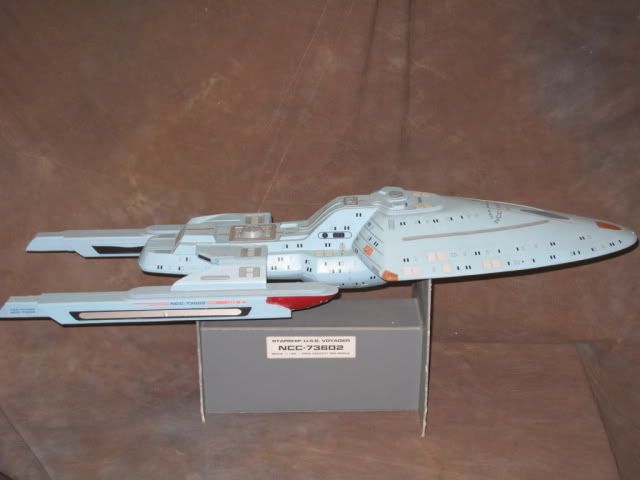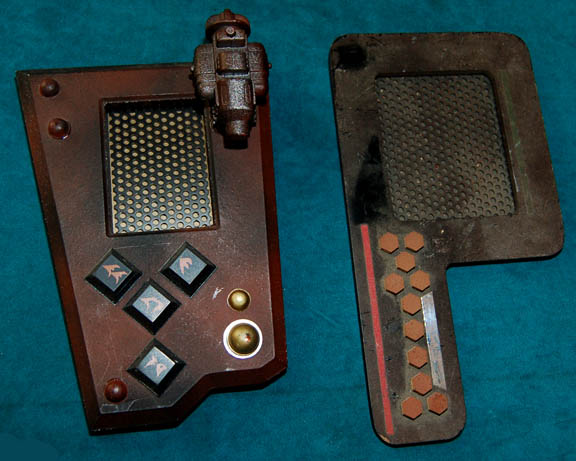
Which starship design is your favorite “child”?
At the moment it’s a toss up between Voyager and the Klingon Attack Cruiser Vor’cha. The Vor’cha was a brand new Klingon ship to follow the D-7, a fabulous design, Matt Jefferies made us look at things in a whole new way back in 1990.
The producers wanted a new Klingon ship because the D-7 had been seen a lot. It’s one of those situations where I rubbed my hands together and said ‘Oh Yeah, oh yeah, this is great, let’s do this!’. It was one of the first complete ships I got to do for the series…the smoothest design cycle was for the Vor'cha. I seem to recall Rick Berman looking at a sketch in a production meeting and saying, "What's not to love?"
The Vor’cha has a very aggressive look, almost like a snake in mid-strike. What was the inspiration?
The Vor'cha was something of a synthesis of the original D-7, Nilo Rodis' Bird of Prey, the updated battle cruiser from the features, and a healthy dose of Starfleet styling, given as there was something of a détente in effect at the time. I'm sure that the Klingons will eventually rework the ship and go back to the dark green hull coatings.
You’ve designed an amazing array of weapons. Which stands out to you most?
My favorite weapon, even though it’s not as elaborate as the Klingon disruptor, is the third series phaser for Next Gen. Rick Berman asked me to redesign the one that used to be called the “Dust Buster”. I had a great time with that one. I also got to do some of the alien weapons, sort of the alien of the week pistols, the Voyager compression phaser rifle was a lot of fun.
What’s your process in designing a weapon?
Doodles, lots and lots of doodles. Sit down with a nice fresh marker and some blank paper and start doodling. Some of the equipment I took cues from things being done with the wardrobe. If (costume designer) Bob Blackman was coming up with a police uniform for an alien culture I would tailor the weapon to work with that style. It would be silly to have a stiff, hard-edged culture and a swoopy looking piece of hardware. I would sit down with the prop masters and we’d talk. Sometimes because of budgets, weapons were recycled, reused, reworked, cut up with a hacksaw and put together a different way.
How about the communicators?
Oh, everything starts with doodles and transitions to more finished pen and ink drawings and finally 3-D renders. We didn't have that last step in the late 1980s, so things like the com badges stopped at the marker-colored drawing stage. A few different communicator devices were sketches, from handhelds to wrist units, but Gene Roddenberry suggested it just be the Starfleet emblem. The shape was simplified, and we came up with ideas for actor gestures and the background tech. At the time of the initial designs, I wasn't completely aware of how small and simplified Gene wanted everything to go, but it all got worked out.
 Another one of your signature creations is the intricately detailed floor of the Romulan Senate Chamber in Star Trek: Nemesis. This wasn’t just a floor with a cool look, it was also a nod to original series.
Another one of your signature creations is the intricately detailed floor of the Romulan Senate Chamber in Star Trek: Nemesis. This wasn’t just a floor with a cool look, it was also a nod to original series.
If you look at the original series, the episode “Balance of Terror”, on one of the long monitor shots, when Enterprise is near the Neutral Zone, they showed Romulan outposts and Federation outposts on opposite sides of the Neutral Zone, which made a slight s-curve. Beyond the fact the Romulan Senate floor was supposed to look like marble or granite, the design was rather like a Yin-Yang symbol, like the monitor shot. Without really bashing people over their heads with the idea, it came from the original series and really symbolized the separation between the Romulan Empire and the Federation.
Over the last two years, Paramount and CBS, through It’s a Wrap Hollywood, have auctioned off more than 10,000 items from their Star Trek warehouses; uniforms worn by starship captains, starship models, Klingon skulls, phasers, LCARS panels, even space plasticware. What are your thoughts on auctions like these?
While it would have been nice to establish some kind of Trek- or general SF-oriented museum to display and maintain some of these miniature and prop and wardrobe items, I'm glad to see that they're going to fans and collectors who have had a genuine interest and devotion to the franchise. (Writer’s note to collectors: As a hobby, Sternbach also auctions some of his original Trek design drawings and small props on eBay.)
What TV shows get your fan blood pumping?
I gotta’ be honest, I’m a huge Stargate fanatic. Aside from the fact that a lot of our guys ended up on their show, including Bob Picardo, aside from that, they do Star Trek very well. I don’t mean that in a snarky way. They learned, they understood what makes a fun, semi-serious, science fiction show. There were a number of very forgettable space science fictions shows and films, like, Space Ranger, I think it was. You’ve got all the standard elements, space ships, astronauts, aliens, and for some reason they didn’t click. What they did with the Stargate concept was brilliant. The idea of a gateway to another star system is as old as science fiction, but what they did with the idea was tremendous.
What are your current projects?
I'm creating new astronomical art using various digital means, producing 3-D physical planetary models, and offering decals for historical spacecraft through my company, Space Model Systems, Inc. It's a really niche market, but between the academic and public outreach and hobby sectors, it seems to be cultivating a bigger audience.
If you could have a Romulan Ale with any of the actors from any Trek series or film, who would belly up to Quark’s Bar with you?
I’d enjoy having a beer with Levar Burton or Bob Picardo because they really get it, what these designs are about, the science behind it.
Actually, I'd add Robbie McNeil and Tim Russ to that bunch, seeing as how they're all into the science and appreciate the wonders of the universe. And I'm pretty sure most of them use Mac computers. Tim's also an amateur astronomer. My kind of folks.
Who’s your favorite captain?
I'd say Picard. Knows what has to be done and gets it done.
Are we alone in this universe? Will we ever develop a true warp drive to find out?
We're probably not alone, though distances and times when civilizations flourish or disappear will likely keep us from ever communicating. The chances that there are multiple civilizations existing out there at any one time are high, but as I say, we're isolated. Will we ever develop warp drive? Never say never, but I think it's unlikely. We will probably develop a propulsion system to get us maybe 10%-50% of lightspeed, but even that range would span a very long time, with no guarantee we'll ever meet anyone else.
Heh. Maybe the furnace that bakes warp coils to perfection.
Will we see another Star Trek series on television?
Probably. It's a rich universe with great potential for characters and new stories. Anyone who says Star Trek is tapped out isn't thinking cleverly enough.
Final question; something that has been the topic of many a term paper, late night debate and occasional bar fight; Ginger or Mary Ann?







